What will automobiles look like 50 years down the road? If they turn out to be anything like these concepts from the design studios of four major automakers, we are in for quite a ride.
* * * * *
- Mazda Motonari RX
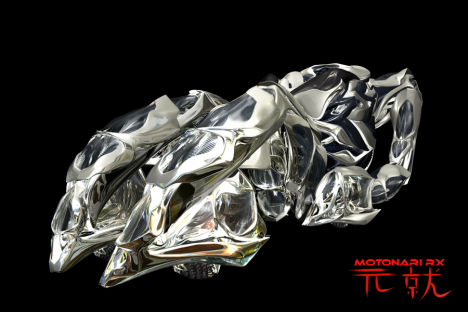
Mazda Motonari RX [+]
In Mazda's vision of the late 2050s, advances in molecular engineering have rendered metal-based manufacturing obsolete. The rise of ubiquitous computing and artificial intelligence drastically accelerates the automotive production cycle. Cars are cheap, lightweight (around 200 lbs, or less than 100 kg), and equipped with intelligent crash avoidance systems that eliminate traffic accidents. However, people still manage to get speeding tickets.
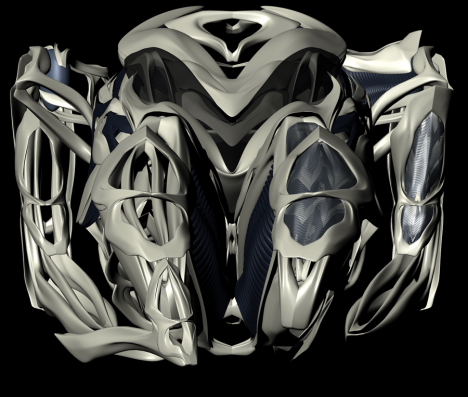
[+]
The Mazda Motonari RX -- which takes its name from the legendary Japanese warrior Mori Motonari -- interfaces seamlessly with the driver to function as an extension of the body.
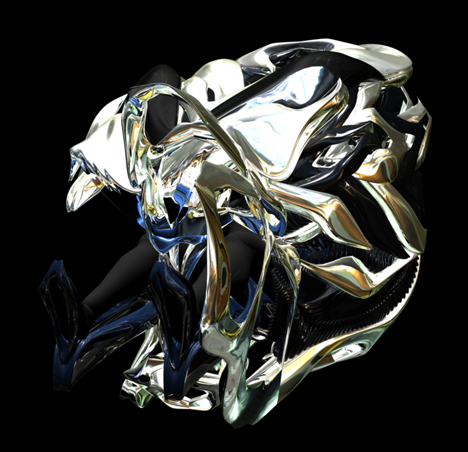
The vehicle drives sort of like a street luge. Acceleration and direction is determined by two armrest mounted control points, and the vehicle's exoskeletal frame shape-shifts in accordance with the position of the driver's arms and legs when enveloped in the seat.
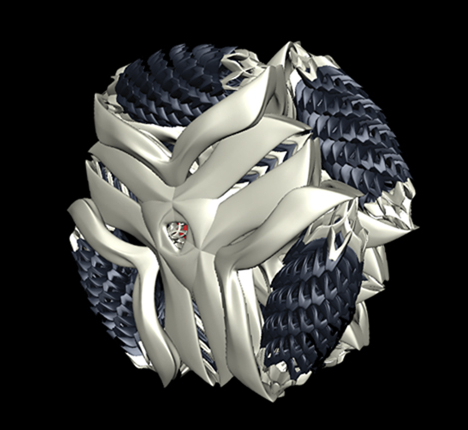
Omni wheels
Four omnidirectional wheels allow 360 degrees of movement, and the tread expands or contracts to suit the driving conditions.
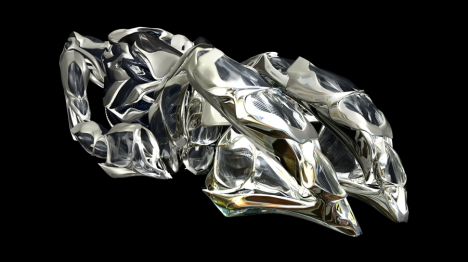
[+]
A "haptic skin" suit consisting of millions of microscopic actuators enables the driver to experience the road psycho-somatically while receiving electrical muscle stimulation from the onboard AI guidance system (or other remotely located drivers).
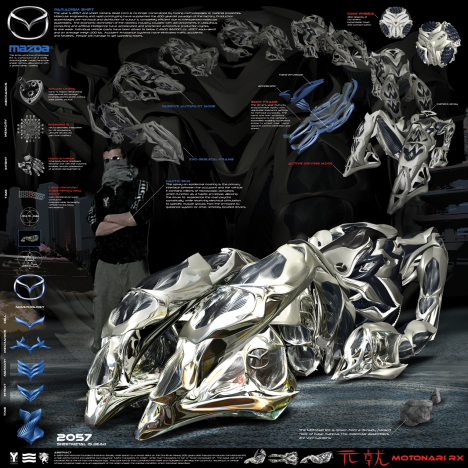
[+]
The vehicle's entire structure is comprised of a 100% reprototypable, carbon nanotube/shape memory alloy weave with a photovoltaic coating, which allows the vehicle to mimic the driver's body movements while powering the in-wheel electrostatic motors. [More]
* * * * *
- Toyota Biomobile Mecha
In Toyota's vision of the late 2050s, cities have developed vertically due to limited area on the ground, leading the transportation industry to develop new vehicles capable of navigating vertical space.
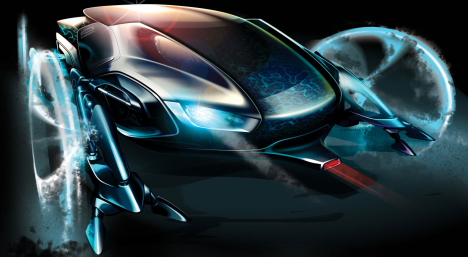
Toyota Biomobile Mecha [+]
Toyota's Biomobile Mecha, a shape-shifting vehicle with nano-laser wheels, can read and adapt to changes in the environment and travel vertical pathways by means of biomimetic feet with powerful suction.
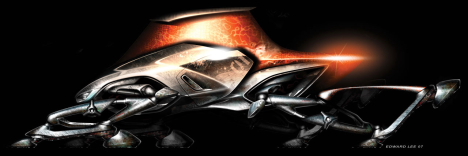
[+]
In addition, the Biomobile Mecha is powered by pollution. A special skin derives energy from harmful substances in the air, so the vehicle never runs out of fuel (as long as the future skies remain polluted) and restores balance to the environment while it goes.

[+]
The real-time strategic navigation planning system, which reads the environment via a 3D scanner, gives the vehicle "instincts" that enable it to autonomously adapt to the driving environment.
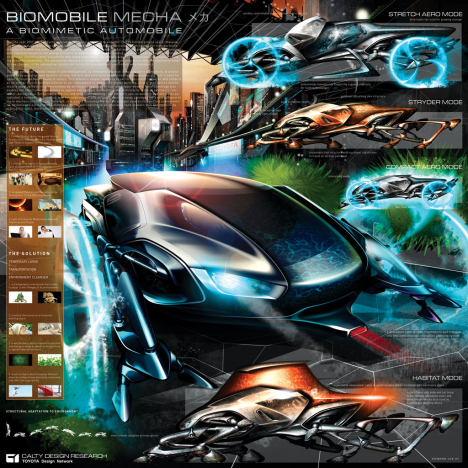
[+]
Advanced nanotechnology enables the vehicle to expand and contract its structure horizontally and vertically as needed, allowing it to serve as a compact commuter, an aerodynamic performance vehicle, or even as a temporary dwelling. [More]
* * * * *
- Nissan OneOne
In Nissan's vision of the 2050s, robots have become an integral part of our lives, blurring the line between humans and machines. The Nissan OneOne combines personal mobility with the family robot concept.
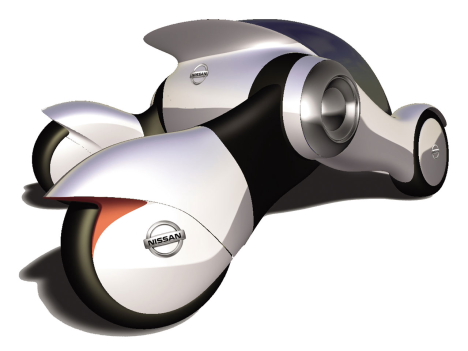
[+]
Billed as the ultimate pet, the Nissan OneOne (pronounced "wan-wan," the Japanese sound for a barking dog) is a friendly, helpful member of the family of the future. Able to operate autonomously without a driver, the GPS-guided vehicle can help out by picking up the dry cleaning, fetching the groceries, and taking the kids to school.
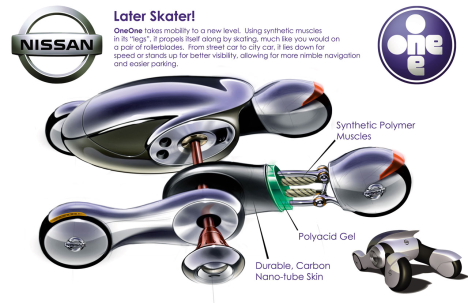
[+]
OneOne propels itself forward by flexing and relaxing synthetic polymer muscles in its "legs," much as you would if skating on roller blades.
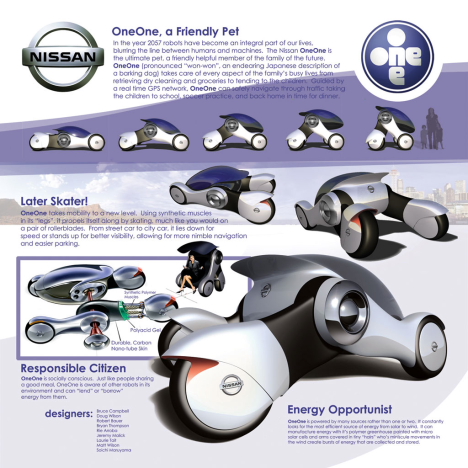
[+]
The vehicle can also assume various positions depending on the driving environment. It reclines to achieve greater speed, and it stands up to increase visibility and squeeze into tight spaces. [More]
* * * * *
- Honda 124 (One to the Power of Four)
In Honda's vision of the 2050s, people have flocked back to the suburbs, fueling consumer demand for a truly flexible commuter vehicle.
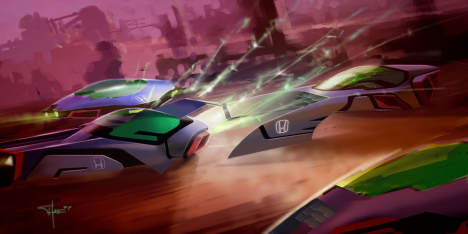
Honda 124 [+]
The solar-hybrid powered Honda 124 (One to the Power of Four) is an energy-efficient, modular vehicle that can separate into four different fully functional units, each uniquely suited for specific driving conditions.
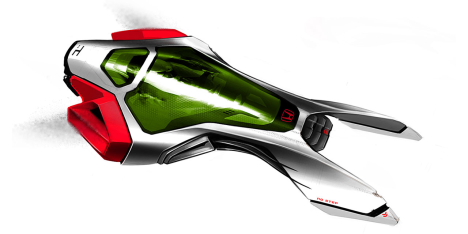
[+]
A combination of robotics, artificial intelligence and molecular engineering (which enables the body panels to be reshaped according to use) allow each module to instinctively reconfigure itself and operate as a fully functional unit. Two of the modules are suitable for short-distance inner-city driving, while the other two are ideal for longer distances at higher speeds.
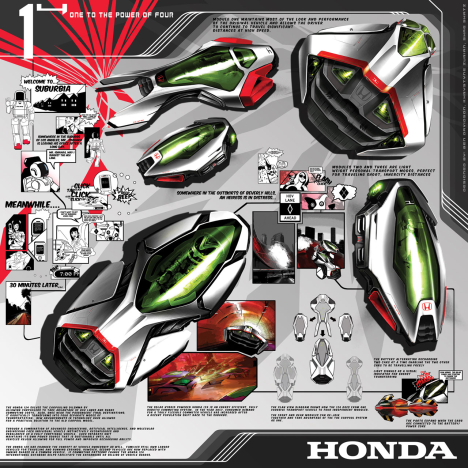
[+]
Because the Honda 124 consists of multiple units that can be joined together, carpoolers can take advantage of HOV lanes and share commuting costs. [More]

Ulrik
Wow, love the Honda Designs!
[]robot makes music
Seriously, except for the Nissan, these are the dumbest things I have ever heard of, reminiscent of Gernsbackian predictions circa 1950 of what now would look like. Turns out now looks a lot like then, just a little bit smaller and with cellphones.
What are the cars of 2050 gonna look like? The Nissan (but probably without wheels the way we think of them). What might a Ferrari look like in 2050? The Toyota maybe, but without the stupid nano-laser wheels.
You can't just stick the word nano into something and have it make fucking magic. And I know their engineers are more intelligent than this. I guess their marketing departments cooked up these ideas. You can't make light solid. You just can't, at least the way we currently understand physics, and there's no hint that that's going to change. If anything, they'd be directional beams pulsing to shove the car along in a certain direction, not spinning wheel shapes of light, and the car would be levitated with room-temperature superconductors (way more probably than anything mentioned above except the Nissan, since we do have experimental superconductors now that run in the range of only -30°C, a vast improvement from the normal -196°C)
[]Malcolm
All very good points and I agree with you 100%. Definately ideas cooked up by the marketing department and not actual engineers with backgrounds in REAL science.
[]dangan
this is all the work of industrial designers. they usually know nothing about the actual science behind any sort of transportation and spend most of their time try to make things more aerodynamic (looking). And why does the Mazda look like a pile of bones? You should see the car i designed that runs on pessimism.
[]Steve
A car that runs on pessimism? No way that will ever work.
[]Pat
More realistic than a car that runs on pollution.
"Hey guys, let's make a techno "skin" that just magically converts any type of pollution I don't understand into clean energy! I'm sure we'll get in the couple of decades! Synergy guys!"
Sigh
[]Joe
I think you dont have the slightest idea of the role of an industrial designer. I doubt those drawings were made by one, as they are purely conceptual, lacking basic functionality, ergonomics, technology and even aesthetics (mainly in the mazda example).
[]MRobbo1984
"..A combination of robotics, artificial intelligence and molecular engineering .."
I agree with Robot - the marketing dept have obviously tried to blind you with science, in a hope that you will buy into these highly improbable, dream mobiles.
you might as well conceive a car that wipes your arse and runs on methane. It would more likely to be produced, than this pile of shite
[]Jig Blogger
Awesome. I love the oneone aka reliant robin. But extra points to Steve for "a car that runs on pessimism? No way will that ever work."
[]AcADIeN
My though on this
Mazda play too much starcraft, it look like a Zerg character
Toyota nano laser and pollution propultion seem like a big dream.
Nissan seem the best of all of them, doable
Honda does look like a speed race game car
[]robot makes music
I figured it out! Honda is trying to design a F-Zero race car!
[]Roe
Maybe if enough people petition we can get Mizuno to make suits like Captain Falcon's . . .
[]graphicartist2k5
the honda and nissan designs are the only ones that are REMOTELY realistic. the other ones are cool conceptual ideas, but most likely won't go into any sort of mass production for a VERY VERY VERY long time. the mazda design looks like a totally cool idea, but honestly, it's not going to happen. it's good to have a dream, but it's also good to be grounded, so you don't go and get all flighty about it, as though the dream you have of driving a car with "nano laser wheels" is actually going to be a reality.
[]Flexo
People will still want to carry "stuff" in the future. None of these concepts allow for cargo and therefore they are no more practical than a motorcycle.
[]Janus Grayden
Here's why these cars were obviously designed by marketing teams with obviously little in the way of actual scientific knowledge:
Actual engineers that live in grown-up land work with the technology that we have either developed or are in the process of developing. Extrapolating out to the 2050s is the domain of people who just want to make stuff up and pretend like they're innovators without actually having to worry about things like seeing if it would actually work. Oh no, but they can't be bothered with that, they're "visionaries."
[]Steve
Wrong! These concepts were not dreamed up in the marketing department.
They are the work of design studios participating in the annual Design Challenge competition that is part of the LA Motor Show. The whole point of the competition is to encourage imaginations to run wild around a designated theme, not necessarily to come up with designs for working vehicles.
The theme was "Robocar 2057" and the participants were asked to explore how artificial intelligence and other emerging technologies will be integrated into automobiles to make life safer, more convenient and more attractive to consumers 50 years from now.
Sure, there may be a lack of hard science, but that's not really the point of the competition. The point is more to stimulate the IMAGINATION.
Interestingly, none of the designs above actually won the competition. The winner was the Volkswagen Slipstream:
http://www.carbodydesign.com/archive/2007/12/10-volkswagen-slipstream-concept/
Note: To you and all the other haters, I'm designing a car powered by the sticks up your butts, a potentially cheap and abundant source of energy if we can find a way to pull them out.
[]Jonathan
*claps!
[]Abate
You're all correct, but I'm not offended by these models. After all, the purpose of the exercises is to stretch ideas, not actually design feasible products. I think of it as R&D on an acid trip...all an artistic, pseudo-sci endeavor. And it stimulates engineers and scientists and everyday people like us to talk about how these things couldn't work...but maybe if they did THIS instead...
Why can't everyone's left and right brain-halves just get along? I say keep the concepts coming, even if we just get a good chuckle out of much of it.
[]Mark Baland
Maybe by 2050 in Japan they will have semi-organic nano-tech robot cars that travel through time and turn into flying robot samurai, but in America, we'll be lucky to get more than 30 something miles per gallon on gas, which will cost $100 a gallon. That is, unless the people rise up against the government and the corporations and end the oil war (where the USA is going to try and take over Iran before China and Russia make a deal to buy their oil) and instead focus on solar, wind, and hydrodynamic power, and abandon the silly hydrogen fuel cel and go back to battery driven electric vehicles...
[]Adrian
My 'sperg-gland is forcing me to point out that 1 to the power of 4 just equals 1!
[]reza
Toyota look like a flying tiger.. very great..
[]